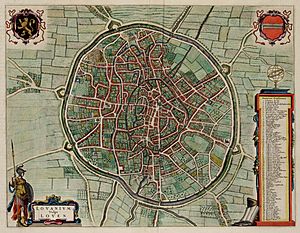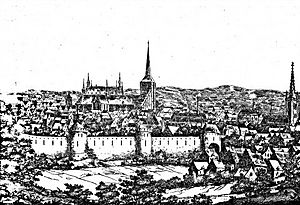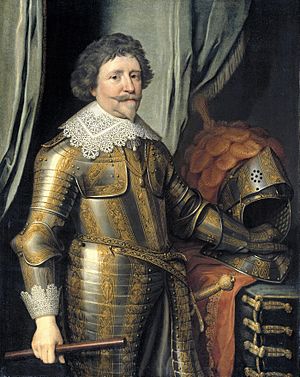Siege of Leuven facts for kids
Quick facts for kids Siege of Leuven |
|||||||
|---|---|---|---|---|---|---|---|
| Part of the Eighty Years' War, the Thirty Years' War and the Franco-Spanish War (1635-1659) | |||||||
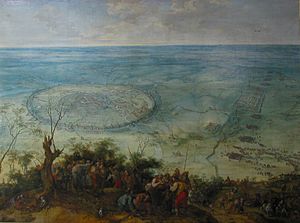 Relief of Louvain. Oil on canvas by Peter Snayers. |
|||||||
|
|||||||
| Belligerents | |||||||
| Commanders and leaders | |||||||
| Strength | |||||||
| Garrison: 4,000 Relief force: 11,000 |
50,000 30,000 Dutch 20,000 French |
||||||
| Casualties and losses | |||||||
| 700 | At least 12,000 casualties | ||||||
The Siege of Leuven was an important battle that took place from June 24 to July 4, 1635. It was part of bigger conflicts like the Thirty Years' War. In this siege, a large army from France and the Dutch Republic tried to capture the city of Leuven. Leuven was located in what was then called the Spanish Netherlands, which is now Belgium.
The city of Leuven was defended by about 4,000 soldiers. These defenders included local citizens, students, and soldiers from different places like Wallonia, Germany, Spain, and Ireland. Their leader was Anthonie Schetz, also known as the Baron of Grobbendonck. The attacking French and Dutch army was much larger, with about 50,000 soldiers. Their leaders included Frederick Henry, Prince of Orange from the Dutch Republic and French Marshals Urbain de Maillé-Brezé and Gaspard III de Coligny.
However, the attacking army faced many problems. They had trouble getting supplies, and many soldiers became sick. When a Spanish and Holy Roman Empire army of 11,000 soldiers arrived to help Leuven, the French and Dutch forces had to give up their attack. This victory allowed the Spanish forces to take control, and the invaders were forced to retreat.
Contents
Why the Siege Happened
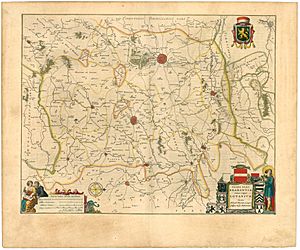
In 1635, the Dutch Republic and France made an alliance. They wanted to attack the Spanish army from two sides. Their goal was to end the long-standing conflict in the Eighty Years' War and divide the Spanish Netherlands between them.
The French army invaded from the south. They won a battle at Les Avins on May 20. After this, they met up with Frederick Henry of Orange's Dutch army in Maastricht. Frederick Henry had brought 20,000 foot soldiers and 6,000 cavalry (soldiers on horseback) from the Dutch Republic.
Meanwhile, Cardinal-Infante Ferdinand, a Spanish leader, was in Leuven. He ordered his Spanish troops to move to Tienen. He also sent a message to Germany asking for help from the Holy Roman Empire's army.
The combined French and Dutch army, now 50,000 strong, marched towards Tienen. Tienen was defended by a small group of soldiers. The French and Dutch attacked the town, took it over, and looted it for three days. Many of the town's defenders and people were killed. This event gave Ferdinand time to make Leuven's defenses stronger. He also set up his army in a protected spot near the city.
The French and Dutch army arrived soon after. They camped a short distance from Ferdinand's headquarters. However, they waited for eight days without attacking. This delay allowed many people from the surrounding areas, especially from Brussels, to escape to safer places. The news of what happened in Tienen had made everyone very scared.
The Siege of Leuven
First Moves
On June 20, the French and Dutch army moved closer to Leuven. They advanced their lines to the eastern side of the Dijle river. Francisco de Moncada, 3rd Marquis of Aitona, a Spanish commander, sent troops to strengthen a fortified bridge over the Dijle. He was worried the invaders would use it to cross the river.
The Spanish troops watched the French and Dutch forces moving over the hills for two hours. Then, they discovered the invaders were crossing the Dijle using an unguarded footbridge. This bridge was about a league away from the first one. The Duke of Lerma quickly sent cavalry and musketeers to stop them.
However, by the time they arrived, more than 4,000 French and Dutch soldiers had already crossed the bridge. They had taken strong defensive positions. The Duke of Lerma realized he couldn't stop them and ordered his troops to pull back.
Fighting at the Walls
That night, all the heavy guns and supplies were moved back to Brussels. The next day, Cardinal-Infante Ferdinand also moved his main camp. He left the defense of Leuven to the experienced commander, Anthonie Schetz, Baron of Grobbendonck.
Grobbendonck commanded several groups of soldiers. These included his son's troops, Walloon soldiers, and Irish soldiers led by Thomas Preston. He also had five companies of Leuven citizens and students from the University of Leuven, plus some cavalry.
The French and Dutch army, after crossing the Dijle, looted the village of Tervuren. This village was a residence of the Dukes of Brabant. Then, they turned back to Leuven to surround the town. The siege began with the allied army firing cannons at Leuven's defenses. Their engineers also dug trenches and mines towards the city's ramparts (walls).
Most of the work happened near the Vilvoorde gate. This gate was defended by Preston and his Irish soldiers. They often made surprise attacks, called sorties, to disrupt the siege works. These attacks easily made the French soldiers, who didn't have enough supplies, lose morale. Walloon troops and university students also made many sorties, destroying the enemy's digging work almost every night.
The attackers were frustrated by these interruptions. They decided to storm the walls, even though it meant facing enemy fire. They hoped their large numbers would help them succeed. One night, three regiments attacked the walls and strong points from their most advanced trenches. But the alert defenders pushed them back with heavy losses.
The next night, Prince Frederick Henry himself led an attack on a small fort, called a ravelin, that protected the Mechelen gate. This fort was guarded by only a few Irish soldiers. Even though the attack started well, the Irish, helped by some German soldiers and citizens, managed to push Frederick Henry back. They caused him serious losses.
A big reason for the attackers' failure was a well-fortified tower between the Mechelen and Vilvoorde gates. This tower was called Verlooren-Kost (Lost Cost). It was used as an artillery position and as a lookout point for Baron of Grobbendonck. From there, he could watch the enemy's movements. When the French and Dutch realized this, they fired many cannons at the Verlooren-Kost tower. However, its walls were 9 meters (about 30 feet) thick and could not be destroyed.
Help Arrives
On June 29, a special day for Saints Peter and Paul, the French and Dutch army remained quiet. Grobbendonck decided to act. He ordered 250 chosen defenders to make a surprise attack. They left from three different gates and met in front of the Verlooren-Kost tower. Then, they stormed the enemy's trenches by surprise. The attacking troops were completely unprepared. About 400 enemy soldiers, including many officers, were killed.
Despite this setback, Frederick Henry still urged Grobbendonck to surrender that same day. He threatened to harm the people of the town if they didn't. However, five days later, help arrived. An army of 8,000 cavalry and other troops, led by Ottavio Piccolomini, reached the outskirts of Leuven. This army had been stationed in Namur and was now reinforced. Another group of 3,000 foot and cavalry soldiers also arrived.
The presence of this large relief army forced the French and Dutch to give up their siege. They were also running low on food. They had to retreat north towards the Dutch Republic. Many of their soldiers deserted (ran away) and were either killed or captured by the Spanish cavalry and local farmers. Soon after, Cardinal-Infante Ferdinand also arrived with an even larger army of 22,000 foot soldiers and 14,000 cavalry.
What Happened Next
The failure of the French and Dutch at Leuven's walls allowed the Spanish to take control of the situation. Cardinal-Infante Ferdinand launched a counter-attack. He pushed the French and Dutch army back towards the Dutch border. He moved northeast towards the Rhine river, taking back towns like Diest and Tienen.
A group of 500 German soldiers managed to surprise and capture the Dutch fortress of Schenkenschans on the night of July 27/28. This fortress was very important. The Dutch quickly sent more soldiers, but they couldn't stop a Spanish army of 20,000 from taking over the Duchy of Cleves in August and September. The Spanish wanted to connect the Schenkenschans fort with the main Spanish Netherlands.
This Spanish presence was a threat to the heart of the Dutch Republic. So, it was very important to deal with it. Frederick Henry himself started a siege of Schenkenschans just days after it fell. However, he soon gave command to his cousin, John Maurice, Prince of Nassau-Siegen. The fort eventually fell back to the Dutch, but only after a very long and costly siege that lasted through the winter.
After securing the Dutch border, the Spanish pushed the French back. They even invaded northern France towards the Somme river, reaching as far as Corbie.
|
See also
 In Spanish: Sitio de Lovaina para niños
In Spanish: Sitio de Lovaina para niños


